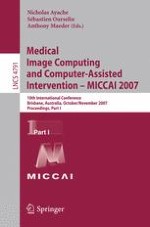2007 | Buch
Medical Image Computing and Computer-Assisted Intervention – MICCAI 2007
10th International Conference, Brisbane, Australia, October 29 - November 2, 2007, Proceedings, Part I
herausgegeben von: Nicholas Ayache, Sébastien Ourselin, Anthony Maeder
Verlag: Springer Berlin Heidelberg
Buchreihe : Lecture Notes in Computer Science
